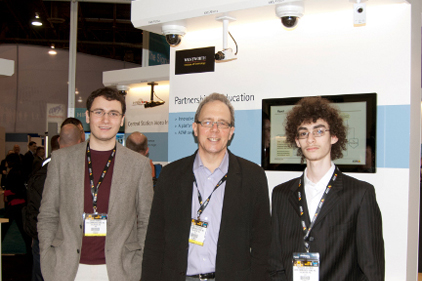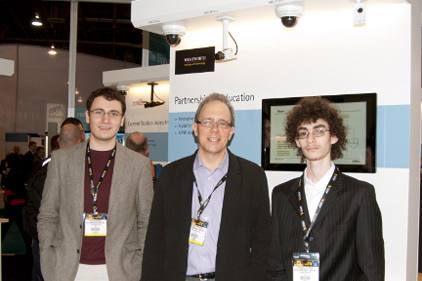
|
| (Left to right) Joshua Ramirez, Chuck Hotchkiss and Nicholas Gelfman from Wentworth Institute of Technology accompanied Axis to ISC West to demonstrate innovations students Ramirez and Gelfman developed as part of the collaboration between Axis and the college. |
“No one wants a camera.” Or so said Fredrik Nilsson, general manager of Axis Communications, at the company’s breakfast event yesterday morning.
Pretty bold words from someone who’s in the business of selling cameras. And if that statement didn’t have you wondering if Nilsson had lost his marbles, his follow-up explanation didn’t sound much better — at least at first.
“People want a safer environment, a safer office or retail establishment or school. How do we know a camera is the best way to provide it?” he said. “The guard market is 10 times bigger than the security video market. Law enforcement is probably 20 to 30 times bigger. So do we really need cameras out there?”
What followed was a game show-styled presentation called “Are You Smarter than a Security Camera?” that pitted humans against cameras in a number of categories. (The answer to the question, in case you were wondering, is “yes and no,” depending on the criteria.) The game creatively highlighted some features of Axis cameras that allow them to be “smarter” than humans, such as low-light performance, people-counting and long-term “memory.”
That led to a discussion of the fact that of all the footage generated by the approximately 20 million security cameras installed in the U.S., only about 1 percent is ever analyzed — hence the need for smarter surveillance, which is a major theme for Axis at the show. Proving that Nilsson made his initial claim with tongue firmly planted in cheek, Axis announced a number of cameras the company is either rolling out or highlighting at the show. Among these are the discreet AXIS P12 network camera series, the ultra-small bullet-style AXIS M2014-E network camera, the 360-degree minidome AXIS M3007-P/PV network cameras, and version 2.0 of its popular Camera Companion, which it debuted at last year’s ISC West.
Nilsson also highlighted a relationship Axis has forged with Wentworth Institute of Technology in Boston. Like smartphone providers, Axis also provides apps for its cameras that allow users to customize them to their unique specifications. The company offered 10 last year, a number that has grown to around 40, thanks in part to the Wentworth relationship.
Axis provided Wentworth professors and students in the college’s computer science and networking program with network video equipment and hands-on training. Professors then encouraged students to design applications they felt would solve real-world challenges for the security industry and others where network video is prevalent — all with no input or influence from Axis.
The ultimate goal of the collaboration is to advance intelligent analytic development. So students, as part of their education — or in many cases, part of their extracurricular activities — have been working to develop apps using
Axis Camera Application Platform, an open platform that enables software developers to create third-party applications that can be downloaded to run inside Axis cameras and encoders.
Two of those students, Nicholas Gelfman and Joshua Ramirez, as well as associate provost and professor
Chuck Hotchkiss, accompanied Axis to ISC West to present the innovations they created over the last semester.
Gelfman created a motion-detection application that can, among other things, enable a camera to detect when an object is moving toward it to protect itself from vandalism and damage. Ramirez, who manages Wentworth’s
Internet radio station, created a dynamic object- and facial-tracking application used for time-logging of recognized objects.



